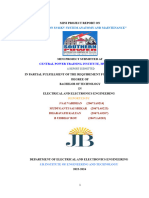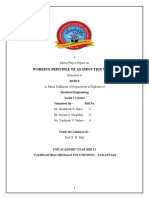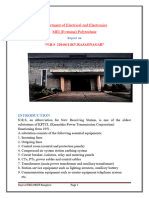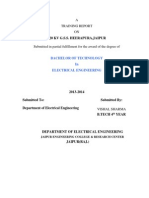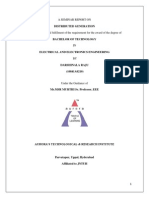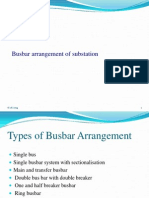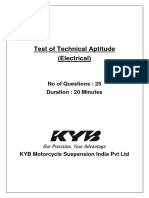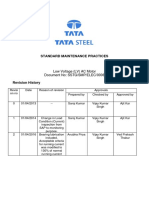0 ratings0% found this document useful (0 votes)
841 viewsWeek 1 Assignment 1 Answers
This document contains the solutions to an assignment on advances in ultra-high voltage transmission and distribution from an NPTEL online course from IISc Bangalore. It addresses 15 multiple choice questions about topics like the power carrying capacity of different voltage lines, the invention of disc insulators, renewable and non-renewable energy sources in India, insulation standards, and the design of high voltage transmission systems.
Uploaded by
Sivaprasad GanjiCopyright
© © All Rights Reserved
Available Formats
Download as PDF, TXT or read online on Scribd
0 ratings0% found this document useful (0 votes)
841 viewsWeek 1 Assignment 1 Answers
This document contains the solutions to an assignment on advances in ultra-high voltage transmission and distribution from an NPTEL online course from IISc Bangalore. It addresses 15 multiple choice questions about topics like the power carrying capacity of different voltage lines, the invention of disc insulators, renewable and non-renewable energy sources in India, insulation standards, and the design of high voltage transmission systems.
Uploaded by
Sivaprasad GanjiCopyright
© © All Rights Reserved
Available Formats
Download as PDF, TXT or read online on Scribd
You are on page 1/ 3
NPTEL Online Course
Advances in UHV Transmission and Distribution
IISc, Bangalore
Week-1 Assignment 1 - Solutions
1. One 765 kV line can carry nearly………. Times power carried by 400 KV
a. 2 b. 4 c. 3 d. 5
Answer: b) 4
2. One 1200 kV line can carry more than ……… times power carried by 756 kV
a. Thrice b. twice c. once d. four times
Answer: b) twice
3. In AC system steady state stability limits is proportional to …….
a. Square of current b. Cube of current c. Square of voltage d. Voltage
Answer: c) Square of voltage
4. Who invented Disc Insulator
a) Buck Harold
b) Edward Hewlett
c) Jorge Thomas
d) Harold Hewlett
Answer: b) Edward Hewlett
5. Renewable energy sources....
a) Fossil Fuel
b) Gas
c) Petrol
d) Hydro
Answer: d) Hydro
6. Coal is abundantly found in India....
a) Telangana
b) Goa
c) Chhattisgarh
d) Karnataka
Answer: c) Chhattisgarh
7. Non-renewable source
a) Solar
b) Wind
c) Petroleum
d) Wood
Answer: c) Petroleum
8. The front and tail times of a standard switching impulse Voltage is defined as:
a) 25/250 µS
b) 250/2500 µS
c) 255/2550 µS
d) 200/2500 µS
Answer: b) 250/2500 µS
9. Important factors responsible for design of 400 kV and above system
a) Pollution & Switching surge
b) Corona & Switching surge
c) Lightning & Switching surge
d) Corona & Lightning surge
Answer: b) Pollution & Switching surge
10. Grid Interconnections system in India
a) Local – State – Regional - National
b) State - Local –Regional – National
c) Regional-Local-State-National
d) National-Local-State-Regional
Answer: a) Local – State – Regional - National
11. Dry arcing distance is a
a) Maximum distance between surrounding medium and end electrodes
b) Shortest distance between surrounding medium and terminal electrodes
c) Distance between ground and high voltage electrode
d) Sum of shortest distance measured along insulating surface between end
conductive parts
Answer: b) Shortest distance between surrounding medium and terminal electrodes
12. Issues with ceramic insulators
a) Flashover, failure, brittle, erosion, corrosion etc.
b) Puncture, cement growth, UV, corrosion etc.
c) Flashover, end fitting, weather, corrosion etc.
d) Flashover, punctures, cement growth, erosion , corrosion etc.
Answer: d) Flashover, punctures, cement growth, erosion , corrosion etc
13. What is the environmental stresses for insulators
a) Heat, cold, UV, contamination
b) Heat, flashover voltage, UV, tension
c) UV, cold, corona, over voltage
d) Over voltage, tension, cold, heat
Answer: a) Heat, cold, UV, contamination
14. What is the mechanical clearance in designing of insulators
a) 0-4 kV
b) 0-8 kV
c) 4-12 kV
d) 4-34.5 kV
Answer: a) 0-4 kV
15. What is the leakage distance and lightning impulse for 66 kV system
a) 59.1 inches, 347 kV
b) 41.1 inches, 347 kV
c) 41.8 inches, 359 kV
d) 46.1 inches, 359 kV
Answer: c) 41.8 inches, 359 kV
You might also like
- Electrical Testing & Commissioning Lab ManualNo ratings yetElectrical Testing & Commissioning Lab Manual2 pages
- 33-11KV Substation Maintenance Report by Jbit Batch 1No ratings yet33-11KV Substation Maintenance Report by Jbit Batch 148 pages
- Presentation On Latest Trends in Power System by Chandan Kumar Chanda71% (7)Presentation On Latest Trends in Power System by Chandan Kumar Chanda43 pages
- Protection of Alternator, Transformers, Bus Bar and Lines: Group 1100% (1)Protection of Alternator, Transformers, Bus Bar and Lines: Group 161 pages
- Synopsis On Underground Cable Fault Detection100% (1)Synopsis On Underground Cable Fault Detection4 pages
- Caterpillar XQ80 Towable Diesel Generator SetNo ratings yetCaterpillar XQ80 Towable Diesel Generator Set5 pages
- A Report On The "3-Phase Line Fault Detector" Ee344 Minor Project - INo ratings yetA Report On The "3-Phase Line Fault Detector" Ee344 Minor Project - I34 pages
- Control and Instrumentation Lab Do's and Don'ts: Do's:: SSM Institute of Engineering and TechnologyNo ratings yetControl and Instrumentation Lab Do's and Don'ts: Do's:: SSM Institute of Engineering and Technology1 page
- Submited by:-VII Semester, IV Year Electrical Engineering Submitted To0% (1)Submited by:-VII Semester, IV Year Electrical Engineering Submitted To23 pages
- UNIT 5.1protection of Motors Busbars and Transmission LineNo ratings yetUNIT 5.1protection of Motors Busbars and Transmission Line11 pages
- Solar Power Train With Automatic Crossing Gates: Project Report On100% (1)Solar Power Train With Automatic Crossing Gates: Project Report On56 pages
- Methods of Improving Transient StabilityNo ratings yetMethods of Improving Transient Stability2 pages
- Unit 4 Power Quality Management in Smart Grid Emc - Electromagnetic CompatibilityNo ratings yetUnit 4 Power Quality Management in Smart Grid Emc - Electromagnetic Compatibility18 pages
- Submitted To: 220 KV Sub-Station CSPTCL Bhilai-3No ratings yetSubmitted To: 220 KV Sub-Station CSPTCL Bhilai-354 pages
- Three Phase Statcom For Reactive Power CompensationNo ratings yetThree Phase Statcom For Reactive Power Compensation25 pages
- Single Phasing of Three Phase Induction MotorNo ratings yetSingle Phasing of Three Phase Induction Motor33 pages
- Power System Operation and Control (18EE81) 20 3-2: Mr. Mohan B S Assistant Professor100% (1)Power System Operation and Control (18EE81) 20 3-2: Mr. Mohan B S Assistant Professor14 pages
- Introduction To Power Quality & Facts - MCQ - Unit-3 - GoWithQuizNo ratings yetIntroduction To Power Quality & Facts - MCQ - Unit-3 - GoWithQuiz4 pages
- Direct - Indirect - Regenerative Method of TestingNo ratings yetDirect - Indirect - Regenerative Method of Testing29 pages
- Presentation On Solar Photovoltaic Inverter System: (SPVS)No ratings yetPresentation On Solar Photovoltaic Inverter System: (SPVS)18 pages
- UPCL Training Report 33/11KV SubstationNo ratings yetUPCL Training Report 33/11KV Substation32 pages
- Government Polytechnic Muzaffarpur: Name of The Lab: Electric Traction-IINo ratings yetGovernment Polytechnic Muzaffarpur: Name of The Lab: Electric Traction-II9 pages
- Industrial Summer Training Report On Uttar Pradesh Power Corporation Limited 220/132 KV Substation Barahuwa GorakhpurNo ratings yetIndustrial Summer Training Report On Uttar Pradesh Power Corporation Limited 220/132 KV Substation Barahuwa Gorakhpur49 pages
- Project Report Speed Control of Induction MotorNo ratings yetProject Report Speed Control of Induction Motor47 pages
- 2.0 Test of Technical Aptitude (Elect) - All - RemovedNo ratings yet2.0 Test of Technical Aptitude (Elect) - All - Removed5 pages
- Vacuum Nanoelectronic Devices: Novel Electron Sources and ApplicationsFrom EverandVacuum Nanoelectronic Devices: Novel Electron Sources and ApplicationsNo ratings yet
- Wireless For The Warrior, Various Series No. 4, Philips DR 30No ratings yetWireless For The Warrior, Various Series No. 4, Philips DR 305 pages
- YDQ5使用维护手册(YDQ Usage and maintenance manual)No ratings yetYDQ5使用维护手册(YDQ Usage and maintenance manual)11 pages
- (4 Marks) (F) Define The Terms P-Type' and N-Type' As It Relates To Semi-ConductorsNo ratings yet(4 Marks) (F) Define The Terms P-Type' and N-Type' As It Relates To Semi-Conductors1 page
- Experiment No: 03: Name of The ExperimentNo ratings yetExperiment No: 03: Name of The Experiment4 pages
- Viper20A-E Viper20Asp-E - Viper20Adip-E: General FeaturesNo ratings yetViper20A-E Viper20Asp-E - Viper20Adip-E: General Features33 pages
- Voltmeters - Ammeters Type DT96 and Type VA01No ratings yetVoltmeters - Ammeters Type DT96 and Type VA012 pages
- Anna University: Chennai - 600 025: Max. Marks: 100No ratings yetAnna University: Chennai - 600 025: Max. Marks: 1003 pages
- Lecture12 Chapter4 - Buck - CCM - AnalysisNo ratings yetLecture12 Chapter4 - Buck - CCM - Analysis39 pages
- User Manual: C440/XTOE Electronic Overload Relay, PROFIBUSNo ratings yetUser Manual: C440/XTOE Electronic Overload Relay, PROFIBUS36 pages
- Profitest 204 Tester For DIN EN 60204 and VDE 0113: ApplicationsNo ratings yetProfitest 204 Tester For DIN EN 60204 and VDE 0113: Applications8 pages

